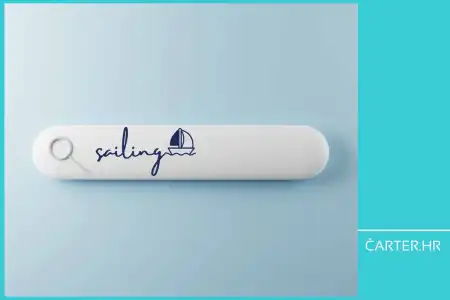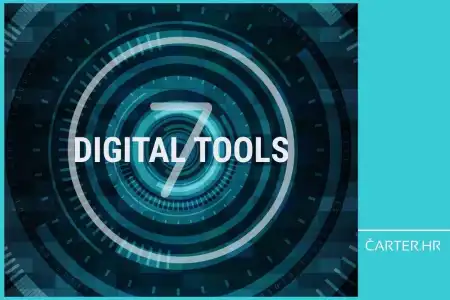
Understanding and using data has never been more important for businesses. In her new article, Andreja Fazlić brings everything about the importance of statistics and benchmarking, showing their impact on business success. Learn how these tools can guide your business in making informed decisions, optimizing operations and achieving greater results.
Starting, developing, and maintaining your own business can be challenging, especially when you don't have historical data or experience to rely on. In such situations, statistics and benchmarking become your best allies.
This is the first of two articles on global statistics, inspired by HubSpot's annual report, "The State of Marketing Report," which you can download at this link.
What are Statistics?
In the context of digital business, statistics represent collected data that provide insights into specific aspects of the business. They can encompass everything from consumer behaviour and marketing campaign effectiveness to sales results. By analysing this data, you can better understand market trends, identify opportunities, identify threats, and make informed decisions.
What is Benchmarking?
Benchmarking is the process of comparing your business with best practices in the industry or with competition. The goal of benchmarking is to identify areas where you can improve your business, including analysing the performance, processes, and strategies used by leading companies so you can apply similar methods and enhance your results.
Why are Statistics and Benchmarking Important for Startup Entrepreneurs?
When you're just starting your entrepreneurial journey, you don't have historical data to rely on. In such situations, statistics and benchmarking provide essential guidelines to help you navigate the market. Here are a few reasons why:
- Informed Decisions: Using statistics, you can decide based on actual data rather than intuition or assumptions (which also have their role in modern business).
- Trend Identification: Statistics help you identify current industry trends, which can assist in adapting and optimising (if you choose to follow them).
- Resource Efficiency: Benchmarking allows you to see how leading companies use their resources and can inspire you to optimise your processes to achieve better results.
- Competitive Advantage: By understanding the competition, you can identify areas needing improvement or differentiation.

Search Engine Optimisation - SEO
SEO helps you better understand how users find information about your brand and your competitors online. By implementing SEO strategies, you increase your website's visibility and ranking on search engine results, which boosts your web traffic and conversion rates.
Conversion Rate
- More than a third of marketing leaders highlight the conversion rate as a key performance indicator (KPI). Nearly two-thirds of marketing professionals report that the average conversion rate on landing pages is less than 10%. Furthermore, 70% of marketers believe that A/B testing is essential and crucial for increasing the conversion rate.
Mobile Search
- Mobile search is predominant, especially among younger users. About 80% of Generation Z and 62% of Millennials prefer mobile search. Additionally, for most marketers, mobile devices generate more than half of their annual traffic.
Organic Search
- 75% of marketers believe that AI-powered search engines will positively impact their blogs, and 68% expect an increase in traffic. Content optimisation based on keywords remains a primary focus for many brands.
Optimisation Recommendations:
Optimise for Mobile Devices
- Given the high share of mobile searches, your website must be mobile-friendly. This includes fast loading, responsive design, and easy navigation. Mobile devices generate a significant portion of traffic, so optimising for a mobile experience is essential.
Use A/B Testing to Improve Conversions
- With A/B testing you can test different versions of your landing pages and marketing campaigns to identify what works best. Considering the conversion rate for e-commerce sites is below 2% in average, testing and optimisation can significantly improve your results.
Focus on Content Optimisation
- Content optimisation according to keywords helps improve search engine ranking. Regularly updating blogs and creating quality content that matches your ideal customers' interests can increase traffic to your site. Using tools and strategies for content optimisation is vital to long-term SEO success.

Email Marketing
Email marketing was and still is one of the most effective ways to connect with customers and build long-lasting relationships. Based on the following email marketing statistics, you can learn how marketers today use email to maximise ROI and establish strong customer connections.
Click-Through Rate (CTR)
- The average click-through rate for emails sent to Constant Contact users is 1.40%. Marketers report that segmented emails achieve 30% more opens and 50% more clicks than non-segmented emails. Additionally, the click-through rate is the most important metric marketing people use to track their email campaigns.
Email Content
- 95% of marketers who use AI for creating emails find it effective, while 54% consider it very effective. 43% of marketers who use AI say it is most useful for creating email content. Using customer names is the most common strategy marketers use to personalise their emails. 47% of email recipients say they open emails based on the subject line, while 69% mark it as spam.
Email Segmentation
- Segmented emails achieve 30% more opens and 50% more clicks than non-segmented emails. 78% of marketers say that segmenting their subscribers is the most effective strategy for their email marketing campaigns. Additionally, 64% of marketers personalise their emails according to specific segments.
Email Use
- 59% of Americans say that most emails they receive are not helpful. Too many emails are the main reason consumers unsubscribe. 40% of email users have around 50 unread emails. Global email users number reached 4.26 billion in 2022, and the projection is that it will grow to 4.73 billion by 2026.
Mobile Email
- 41% of email views, including 75% of Gmail email views, come from mobile devices. 35% of email marketers use a mobile-first approach or mobile-responsive design.
Optimisation Recommendations:
Subscriber Segmentation
- Subscriber segmentation can significantly increase open and click rates. Consider using various criteria for segmentation, such as demographics, interests, and customer behaviour, to send relevant and personalised messages.
Email Personalisation
- Using customer names and personalised content can enhance recipient engagement. AI can be a great tool for creating compelling and tailored email copies that attract attention and encourage action.
Optimisation for Mobile Devices
- Given the high share of email views from mobile devices, ensure your emails are mobile-friendly. Use responsive design to make them easily readable and attractive on smaller screens.

Sales
A good relationship between marketing and sales is crucial for success. When your sales team has access to all necessary information about marketing activities, it can work more efficiently, ultimately helping to increase interactions with potential customers and achieve more sales.
CRM (Customer Relationship Management)
- 61% of sales leaders have automated their CRM software in the year 2023. 78% of them say their CRM effectively improves alignment between sales and marketing teams. The most successful salespeople spend approx. 18% more time updating their CRM. 91% of companies with ten or more employees use CRM software to manage customer data. 45% of companies reported that using CRM software increased their sales revenue.
Sales
- Global retail sales are projected to exceed $30 trillion by 2026. 22% of marketing leaders state that revenue and sales growth is their primary goal. 96% of potential customers conduct their own research before speaking with a human sales representative. More than half of sales leaders use sales support content, and 79% say these materials are crucial for successful sales.
Service Level Agreement (SLA)
- 85% of marketers with an SLA believe their marketing strategy is effective. Companies with an active SLA are more likely to achieve higher year-over-year ROI compared to those without an SLA. 31% of them are more likely to hire additional salespeople because of higher demand.
Social Selling
- Businesses prioritising social selling are 51% more likely to meet their sales goals. LinkedIn sales professionals with a strong social selling index have 45% more sales opportunities than those without a strong index. When people see brand messages on LinkedIn, they are six times more likely to convert.
Optimisation Recommendations:
Implementing a CRM System
- Automate your CRM system to improve alignment between sales and marketing teams. CRM software can increase sales revenue and enable more effective customer data management.
Optimising Sales Strategy
- Use sales support content to enhance the success of the sales process. Including information that potential customers seek can help in making the sales cycle and increasing the conversion rate.
Introducing Social Selling
- Actively use social media for sales to increase the number of sales opportunities. Focus on building a good online presence and engage with future customers on LinkedIn or other networks where your ideal customers are present.

Advertising
Advertising can help attract customers, increase brand awareness, and generate revenue. The following advertising statistics will help you understand how consumers perceive paid media today and which advertising tactics work best for companies aiming to attract new customers.
Key Statistics:
Ad Blocking
- Marketing experts say that Google's planned phase-out of third-party cookies has significantly impacted their marketing strategies this year. In 2022, 35.7% of global Internet users used ad blockers while browsing online content. Ad blocking is most common in countries like China, Indonesia, and Vietnam, where over 40% of internet users use these tools. People from age 18 to 29 are more likely to use ad blockers, while younger teens and older age groups are less inclined. Globally, there are 530 million mobile ad blocker users and 290 million desktop ad blocker users.
Display Advertising
- 22% of marketing experts use display ads as part of their marketing strategy. In 2022, display ads accounted for 30% of all digital advertising spending. Nine out of ten dollars spent on display advertising in the United States are allocated through programmatic buying. The retail industry spends most of its budget on display ads, making up 24.7% of US expenditure. US e-commerce is expected to spend over $15 billion on display ads by 2026.
Mobile Advertising
- Global spending on mobile advertising is expected to exceed $300 billion by 2024. The United States leads the world in mobile advertising spending, with over $150 billion in annual expenditures. China is the second-largest market for mobile advertising, with annual spending nearing $115 billion. American marketing experts report that 19% of their marketing budgets are allocated to mobile advertising. More than half of web traffic in the world comes from mobile devices, making this platform crucial for advertisers. Most marketers report that mobile devices account for over half of their annual traffic.
Pay-Per-Click (PPC) Advertising
- With effective optimisation, PPC advertising can yield average returns of $2 for every dollar spent, translating to a 200% return on investment. Personalised landing pages can make PPC campaigns 5% more effective. Additionally, 84% of brands and marketers reported achieving good results with PPC advertising campaigns.
Video Advertising
- Spending on video ads is expected to make over $191 billion in 2024 and over $240 billion by 2028. 92% of video marketing professionals report that video advertising provides a good return on investment. Up to 91% of businesses use video as a marketing tool. TikTok generated $4 billion in revenue from ads in 2022, with this revenue expected to double by 2024.
Optimisation Recommendations:
Considering the Impact of Ad Blockers
- Given the growing trend of ad blocking, it is important to consider alternatives like native advertising and sponsored content that integrate seamlessly into the user experience without being intrusive.
Leveraging Mobile Advertising Potential
- Mobile advertising is becoming increasingly important with the rising share of mobile web traffic. Tailor your ads for mobile devices and ensure they are optimised for smaller screens.
Using Video Ads for Higher ROI
- Video advertising shows a high return on investment. Investing in short, engaging videos that capture attention can significantly improve your advertising effectiveness. Focus on platforms like YouTube and TikTok to expand your reach.

Regardless of the size of your business, relying on statistics and benchmarking can provide key insights for making informed decisions. Using these tools, you can clearly identify opportunities for optimising and improving optimisation your business processes.
In the next article, I will present additional statistics and tips on leveraging them for your company's growth and development.
Categories of trends
- News
- Sale
- Marketing
- SEO
- Web design
- Social media
- Technology
- Regulations
- Management
- Education
- Finances
- User experience
Newsletter
Sign up for the newsletter and receive the latest trends and tips straight to your inbox




